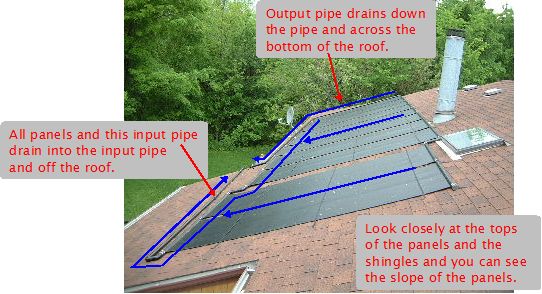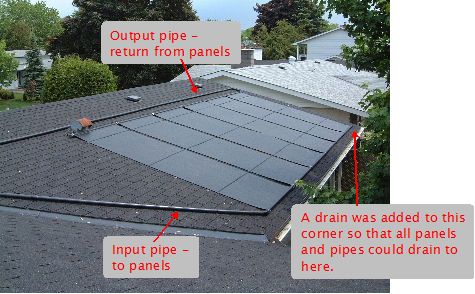Solar Pool Heating - Maintenance
In a climate where water freezes in the winter, such as here in Ottawa, Canada, any water still in the pipes during the winter would turn to ice and possibly damage the pipes, creating leaks to be fixed in the spring. Draining the water out of the system in the fall to avoid this problem is the only maintenance needed.
If you're using solar panels (rather than a spiraled hose for example) then whoever installed your system may have designed it such that any water in the panels or pipes will naturally drain downward to the pump without any places where the water will have to run upward. If you look very carefully at the photos below you'll see that at least the bottoms of the panels are all tilted in the same direction so that even the set of all panels is self-draining. Likewise, any pipes running horizontally along the roof are sloped.


The first step to draining your system is to turn the control valve to the position that allows water to flow up to the solar collectors. The control valve in the following diagrams (the part on the left in each diagram) has two positions. The diagram on the left shows the position for allowing water to flow up. With an automatic control valve this is usually the test position on its control dial.


Some automatic control valves can be turned by hand. For manual control valves, this is of course easy to do. I've repaired one valve where the valve cracked because the piping arrangement near the valve allowed water to sit in the valve over the winter. Had the customer turned the valve such that the blocking piece was not blocking anything then the water would have completely drained out of the valve and it would not have cracked. In fact, if your valve has a third position where the blocking piece is not blocking any water flow at all then that would be ideal. In the above diagrams, the blocking piece can actually be rotated such that neither direction is blocked (not shown.)
But for water to drain from the pipes and solar collectors, air must be able to get in to replace it. If a vacuum breaker valve has been installed in your system then this will take care of it by allowing air in when water is being sucked out. Not all systems have a vacuum breaker valve though.
If there is no vacuum breaker valve then simply turning off the pump and setting the valve position will not be enough. In that case, whoever installed your system will also have included some locations where you can either open a pipe right up or at least have some plugs which you can unscrew, letting air in. You'd then leave the pipes open and/or plugs off for the winter.
The best way to make sure you got all potentially damaging water out is to blow and/or suck the water out with an air compressor or shop vac (vacuum). This is done by opening the pipes in at least two locations, hopefully parts were installed in places along the pipe run for doing this, and blow/suck at one open location. For more assurance you could then go and do the same to the other open location.
Some systems can't be self draining. Examples of these are ones where:
- the pool is at a higher level than the pool pump,
- a trench is involved,
- the roof is not just one flat surface but has obstructions such as those caused by dormer windows which means the pipes may have to run upwards over the obstructions at points, and/or
- the solar collectors are spiraled hoses.
In this case blowing/sucking out the system will be an absolute necessity.
If it's possible that rodents or birds might enter any open pipes and start making a home, you might want to cover the open pipe ends with a piece of cloth for the winter.
In the spring you simply close the open pipes, turn the control valve such that water will NOT flow up to the solar collectors, let the pool pump run for a few minutes, then turn the control valve such that water will flow up to the collectors. Plenty of air bubbles will flow into your pool for a minute or so as air is flushed from the system but this will stop once the system is filled with water. If you have an automatic control valve, set it to automatic. Depending on how much sun you get, your system should heat up the pool within a few days to a week. Enjoy your solar heated pool.
